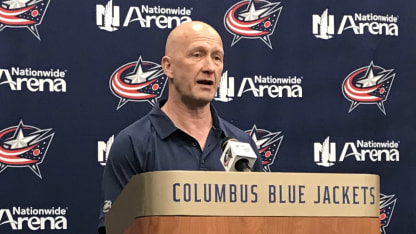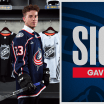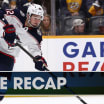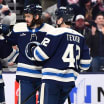Earlier this week,
we published a breakdown
of how the 34 players the Blue Jackets had who played a game with the team and ended the year on the roster were acquired.
As it turns out as we near the 2019 NHL draft that half of those players were drafted by Columbus, showcasing the importance of the annual picking festivities.
Which leads to an obvious question -- what is the impact, then, when it has only two picks in the seven-round draft?
Building the Blue Jackets: What's next at the NHL draft
Columbus has only two picks right now, but what does history tell us that means?

That's where the Blue Jackets find themselves going into this year's event, which is scheduled for June 21-22 in Vancouver.
Thanks to a number of trades over the past two seasons, Columbus enters the draft with only its original third-round pick as well as Calgary's seventh-round pick in the 2019 draft.
In addition, the Jackets have traded their second- and third-round picks in the 2020 draft, and will lose their 2020 first-rounder if Matt Duchene re-signs this summer. The second-round pick in 2021 and the 2022 fifth-round pick also have been dealt, leaving Columbus without a full complement of picks in each of the next four drafts.
So, what does this mean for the future of the franchise?
As it turns out, there's a variety of answers to this question, which all can be traced back to one fundamental truth -- the value of a draft pick has many different answers.
Valuing a pick
Let's start there. A team can acquire players only in a finite number of ways, and the draft is one of them. Each team starts out a year's draft with seven picks, one in each of the rounds based on the standings of the previous year, and it goes from there. There are other ways to acquire players -- on the open market either at the start of a career or mid-career, in trades and on waivers -- but the draft is one of the primary sources for any team's talent pool.
From there, it seems inherently obvious, but a draft pick that is higher in the picking order is much more likely to turn into an NHL success and thus has a lot more value.
The answer to how much is an intriguing one, and research shows that a higher pick at the top of the draft is worth considerably more than one at the lower end. In fact, a top-10 pick has considerably more value than a pick at the end of the first round, and
things largely trend downward then plateau from there
.
You can click on that link for the data, but here's a couple of anecdotal examples to drive the point home. While researching a story on Blue Jackets All-Star forward Cam Atkinson from earlier this year, I found that
30 of the 44 players
who took part in this year's NHL All-Star Game were first-round picks, many of them in the top 10 of the draft. From there, six of the All-Stars were second-round picks, meaning just eight players at the event were chosen from rounds three until the end (in fact, Atkinson was the only sixth-round pick to take part).
In another story about Atkinson
when he played in his 500th game
, I found that of the sixth-round picks taken in the 10-year span from 1999 to Atkinson's 2008 draft, less than 30 percent made it to the NHL level, and only about 6 percent -- or about two sixth-round picks in each draft -- had careers that last 500 games, the equivalent of just over six seasons.
In other words, you're much more likely to miss than hit once you pass a certain point in the draft, and that's still quite true among third-round picks in that span (less than 50 percent make it to the NHL, while just over 10 percent have careers of 400 games or more).
This leads to two separate revelations that are sort of paradoxes of one another -- the value of an individual draft pick is pretty low as you get into the lower rounds. But at the same time, there's value to having more picks, as in a world where the hit rate is so low, the more picks you have, the more likely you are to end up picking something useful.
Jarmo on picks
So how does this impact the Jackets? Well, let's go back to something general manager Jarmo Kekalainen said on exit day after the team lost to Boston in the second round of the playoffs.
The GM was largely credited around the NHL for taking a chance and going "all in" with four separate deals involving trades of draft picks at the trade deadline despite the looming free agency of stars Artemi Panarin and Sergei Bobrovsky.
At the time, Kekalainen gave a variety of justifications for the decision, including his belief the team currently boasts a solid prospects pool that will help it stay competitive in the coming years when paired with the existing core.
But he also pointed out that draft picks are no sure thing, either.
"If we have to go through a draft with not so many picks, so be it," Kekalainen said. "There's one experienced hockey guy that I talked to at the general managers' meetings and his first comment was, 'Oh, you guys took a pretty big risk,' and I said, 'Yeah.' And then he said, 'Well, you know, in my years with this organization, we were there three years and didn't get one player from the draft.' And I said, 'There you go!'
"It's not set in stone that those picks are going to turn into players. With our scouts, they probably would … but that's just the nature of the draft. If you have two players come out of seven rounds, that's a really good result. You can all do the math -- that's not that high. If you get three, it's (an) unbelievable (draft). If you get four, now you're off the charts. So two is a good result; a lot of times it's zero or one.
"Draft picks are valuable, yes, but at the same time they're just an opportunity to try to pick a good player. Unless you get an impact player from the draft -- you can get average players from waivers. You can get NHL players from waivers. Impact players are not usually available unless you draft them, and impact players don't usually come outside of the top 10."
So where does that leave the CBJ?
A former scout, Kekalainen loves the scouting game and loves drafting players. But as general manager, he also knows the math.
As he pointed out there, with a much more successful team than in the past, that picking later in the draft means your first-round pick takes on a lesser value than, say, a top-10 pick. This year, Columbus earned the 19th overall pick, the same slot in which the franchise took Kerby Rychel (43 NHL games, three goals in his career) in 2013. (Ottawa now owns that pick thanks to the Duchene deal.)
Also, it takes some time for players chosen outside of the very top of the draft to make it to the NHL level and become productive players. Players are generally chosen after their age 18 season, and most taken outside of the first round will still have two to three years of junior/college/overseas hockey remaining, not to mention potential AHL time, before even making their debut.
As we posted Tuesday, of the 17 players chosen by the Blue Jackets in the draft who suited up for this year's team, seven of them were selected by former general manager Scott Howson, who last drafted for the CBJ in 2012. A player like Josh Anderson, thought to be part of the Blue Jackets' young core, was a Howson pick. Another young piece just coming into his own, Oliver Bjorkstrand, was chosen in 2013, Kekalainen's first season.
All of which is to say the Blue Jackets, with their current lack of picks in the upcoming drafts, haven't really mortgaged the future and likely won't be hurting too much in the next two to three seasons by trading what they have thus far. It's longer down the road where the impact would be felt -- and the team has time to restock the cupboard before that time.
"Most of the time the draft picks take five years before they're going to help you, so if we give up a 2021 draft pick, you do the math," Kekalainen said at the deadline. "It's 2026 before they're going to make an impact on the Blue Jackets, so we have some time to figure that out."
So now that we've posted the parameters of what it means to have a draft pick, it's easier to answer the question of where the Blue Jackets go from here.
The reality is in any pro sports league, you have to have a constant influx of talent or you'll have to pay the piper. That's especially true in a salary cap league, where you can't just sign any player you want for any price.
This is why there's a good chance you'll see the Blue Jackets try to swing some deals at the draft in late June to bring in picks. Any pieces that can be picked up can help fortify the ranks down the road, especially as you consider the Blue Jackets under Kekalainen have shown the ability to turn third-, sixth- and seventh-round picks like Bjorkstrand, Vladislav Gavrikov and Markus Nutivaara, respectively, into NHL players.
"We have to get back to work on getting some more picks," Kekalainen said on exit day. "Every time we're going to miss an opportunity to try to pick a player that may or may not become an NHL player, we're probably going to grind our teeth a little bit, but we wanted to give this group the best possible chance we could to win the Cup."
That's the opportunity cost of the whole thing, and this year's reward was solid (a first-round sweep of a historic regular-season winner in Tampa Bay) but not the ultimate one.
In other words, it all comes down to a balancing act. The team would rather have more picks than not have them, but the opportunity to win sometimes necessitates hard decisions. It's a constant balance between present and future, and in a league with finite resources, sometimes one wins out over the other.
Columbus went for the present in late February. Its future, now, is what it will try to piece together over the coming weeks.


















